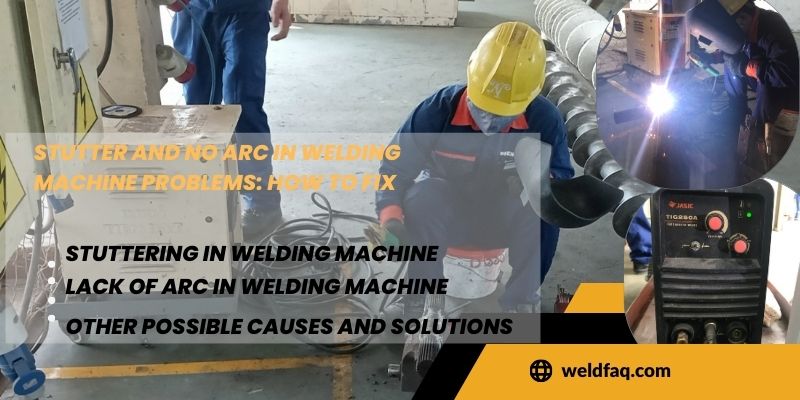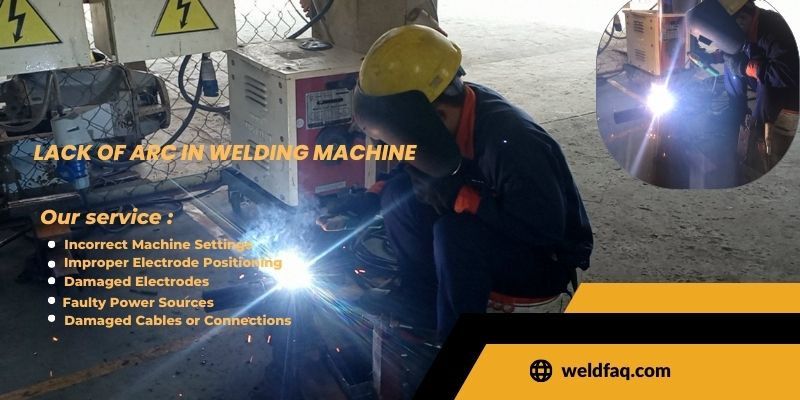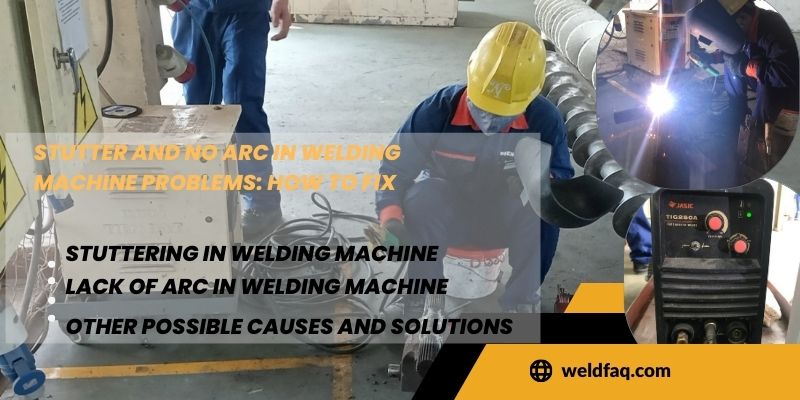Welding machines are crucial tools in the welding process, but they can experience problems that affect the quality of welds. Two common welding machine problems are stuttering and lack of arc. In this article, Weld FAQ will discuss these issues and provide solutions on how to fix them in the below post: “Stutter and No ARC in Welding Machine Problems: How to Fix“.
Stuttering in Welding Machine
Stuttering in a welding machine refers to the irregular or interrupted feeding of the welding wire during the welding process, resulting in inconsistent welds and poor quality. This problem can be caused by worn or damaged drive rollers, improperly tensioned wire, or malfunctioning wire feeder motors. To fix stuttering, the specific cause needs to be identified and addressed.
If the drive rollers are worn or damaged, they can fail to grip the wire properly, causing it to slip or stutter during feeding. In such cases, the damaged drive rollers need to be replaced. Improperly tensioned wire can also cause stuttering as the wire may not be fed at a constant rate. To fix this, the tension should be adjusted to ensure proper wire feeding. A malfunctioning wire feeder motor can also cause stuttering, and it may need to be repaired or replaced to fix the issue.
To troubleshoot stuttering in a welding machine, it is essential to examine the wire feeding mechanism and check for any visible signs of damage or wear. Any damaged or worn components should be replaced, and the wire tension should be adjusted if necessary. Regular maintenance of the welding machine can prevent stuttering issues from occurring and ensure consistent and high-quality welds.

Lack of ARC in Welding Machine
Lack of arc in a welding machine is another common issue that can occur during the welding process. It happens when the welding machine fails to produce an electric arc, which is necessary to generate heat and melt the metal for welding. Here are some possible causes of a lack of arc in a welding machine:
- Incorrect Machine Settings: If the welding machine’s settings are not configured correctly, it may fail to produce an electric arc. This can occur if the voltage or current is set too low, or if the polarity is incorrect for the type of welding being performed. Checking and adjusting the machine settings can fix this issue.
- Improper Electrode Positioning: The position of the electrode in the welding gun can also cause a lack of arc. If the electrode is not inserted properly, or if it is too far from the workpiece, the electric arc may not form. Proper electrode positioning is crucial to ensure the formation of the electric arc.
- Damaged Electrodes: Electrodes are an essential part of the welding process and can wear out over time. If the electrode is damaged or worn, it may not be able to produce an electric arc. Replacing the damaged electrode can solve this issue.
- Faulty Power Sources: A faulty power source can also cause a lack of arc in a welding machine. If the power source is not providing enough voltage or current, the electric arc may not form. In this case, the power source may need to be repaired or replaced.
- Damaged Cables or Connections: Damaged or loose cables and connections can also cause a lack of arc in a welding machine. If the cables or connections are damaged, they may not be able to transmit the necessary voltage and current to produce the electric arc. Checking and repairing or replacing the damaged cables and connections can fix this issue.
In summary, a lack of arc occurs when the welding machine fails to produce an electric arc during the welding process. This issue can be caused by incorrect machine settings, improper electrode positioning, or damaged electrodes. To fix this problem, the specific cause needs to be identified and addressed. One way to troubleshoot is to check the machine settings, adjust the electrode positioning, and replace the damaged electrodes.

Other Possible Causes and Solutions
Other possible causes of stuttering and lack of arc include faulty power sources, damaged cables or connections, or malfunctioning electrode holders. To fix these issues, the specific cause needs to be identified and addressed. It is important to follow proper safety procedures when troubleshooting and fixing welding machine problems:
- Faulty Wire Feeder: A faulty wire feeder can cause stuttering or inconsistent feeding of the welding wire, resulting in poor quality welds. This issue can be caused by worn-out or damaged wire feed rollers, faulty wire feed motor, or faulty control board. To fix this issue, the specific cause needs to be identified and addressed.
FAQ: How can I tell if the wire feed rollers are worn out? Answer: Check for visible signs of wear such as flat spots, cracks, or grooves in the rollers. If they appear worn or damaged, they should be replaced.
- Gas Flow Issues: In gas metal arc welding (GMAW) or metal inert gas welding (MIG), proper gas flow is necessary to shield the weld from contamination and to prevent porosity. Insufficient or improper gas flow can cause poor-quality welds or a lack of arc. This issue can be caused by a clogged gas nozzle, a faulty gas regulator, or a damaged gas hose. To fix this issue, check the gas flow rate and ensure that the gas nozzle is clean and undamaged.
FAQ: How can I tell if the gas nozzle is clogged? Answer: Look for signs of debris, dust, or foreign material on the gas nozzle. You can also remove the nozzle and clean it with a soft brush or compressed air.
- Contaminated Welding Surface: Welding surfaces that are contaminated with oil, rust, or other impurities can cause stuttering or a lack of arc. This issue can be fixed by thoroughly cleaning the welding surface before welding.
FAQ: What is the best way to clean a welding surface? Answer: Use a wire brush or grinding wheel to remove any rust or impurities from the surface. Use a degreaser to remove any oil or grease from the surface.
- Electrical Interference: Welding machines can be affected by electrical interference from nearby equipment or power lines. This can cause stuttering or a lack of arc. To fix this issue, ensure that the welding machine is located away from other electrical equipment, and use a surge protector or noise filter.
FAQ: How far away should the welding machine be located from other electrical equipment? Answer: It is recommended to keep a minimum distance of 10 feet between the welding machine and other electrical equipment.
In conclusion, identifying and addressing welding machine problems such as stuttering and lack of arc is crucial to ensure the quality of welds. By troubleshooting and fixing these issues, welders can produce high-quality welds that meet industry standards. It is important to seek professional help if you are unsure of how to properly troubleshoot and fix welding machine problems.
In summary, stuttering and lack of arc are common welding machine problems that can be fixed by identifying and addressing the specific cause. Troubleshooting these issues and fixing them will ensure that welders produce high-quality welds that meet industry standards.
If you want to watch a video, here a video “COMMON MIG WELDER FAULTS AND HOW TO FIX THEM” (source: UrchFAQ Yotube channel)

